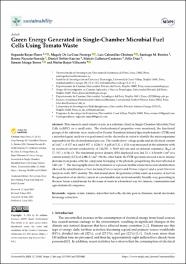Green Energy Generated in Single-Chamber Microbial Fuel Cells Using Tomato Waste

View/
Download
(application/pdf: 3.314Mb)
(application/pdf: 3.314Mb)
Date
2023-07-03Author(s)
Rojas-Flores, Segundo
De La Cruz-Noriega, Magaly
Cabanillas-Chirinos, Luis
Benites, Santiago M.
Nazario-Naveda, Renny
Delfín-Narciso, Daniel
Gallozzo-Cardenas, Moisés
Diaz, Félix
Murga-Torres, Emzon
Rojas-Villacorta, Walter
Metadata
Show full item recordAbstract
“This research used tomato waste as a substrate (fuel) in Single Chamber-Microbial Fuel
Cells (scMFC) on a small scale. The electrochemical properties were monitored, the functional
groups of the substrate were analyzed by Fourier Transform Infrared Spectrophotometry (FTIR) and
a microbiological analysis was performed on the electrodes in order to identify the microorganisms
responsible for the electrochemical process. The results show voltage peaks and an electrical current
of 3.647 ± 0.157 mA and 0.957 ± 0.246 V. A pH of 5.32 ± 0.26 was measured in the substrate with
an electrical current conductivity of 148,701 ± 5849 mS/cm and an internal resistance (Rint) of
77. 517 ± 8.541 Ω. The maximum power density (PD) displayed was 264.72 ± 3.54 mW/cm2 at a
current density (CD) of 4.388 A/cm2
. On the other hand, the FTIR spectrum showed a more intense
decrease in its peaks, with the compound belonging to the phenolic groups being the most affected at
3361 cm−1
. The micrographs show the formation of a porous biofilm where molecular identification
allowed the identification of two bacteria (Proteus vulgaris and Proteus vulgaris) and a yeast (Yarrowia
lipolytica) with 100% identity. The data found show the potential of this waste as a source of fuel for
the generation of an electric current in a sustainable and environmentally friendly way, generating in
the near future a mechanism for the reuse of waste in a beneficial way for farmers, communities and
agro-industrial companies.“
Collections
- SCOPUS [380]

